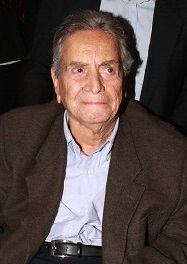Marcello Alencar facts for kids
Quick facts for kids
Marcello Alencar
|
|
|---|---|
 |
|
| 57th Governor of Rio de Janeiro | |
| In office January 1, 1995 – January 1, 1999 |
|
| Lieutenant | Luiz Paulo |
| Preceded by | Nilo Batista |
| Succeeded by | Anthony Garotinho |
| Mayor of Rio de Janeiro | |
| In office January 1, 1989 – January 1, 1993 |
|
| Preceded by | Jó Antônio Rezende |
| Succeeded by | Cesar Maia |
| In office December 5, 1983 – January 1, 1986 |
|
| Preceded by | Jamil Haddad |
| Succeeded by | Saturnino Braga |
| Personal details | |
| Born | August 23, 1925 Rio de Janeiro, Brazil |
| Died | June 10, 2014 (aged 88) Rio de Janeiro |
| Political party | PDT (1980–1993) PSDB (1993–2014) |
| Profession | Lawyer |
Marcello Nunes de Alencar (born August 23, 1925 – died June 10, 2014) was an important Brazilian politician and lawyer. He was the Governor of the state of Rio de Janeiro from 1995 to 1999. He also served two terms as Mayor of the city of Rio de Janeiro from 1983 to 1986 and again from 1989 to 1993.
Contents
About Marcello Alencar
Marcello Alencar was born in Rio de Janeiro. He became a lawyer and helped people who were held for political reasons during Brazil's time under a military government. This was a period when the country was ruled by the military.
Becoming Mayor of Rio
Alencar became the head of a big bank called Banco do Estado do Rio de Janeiro. This important job helped him get into politics. He joined the Democratic Labour Party, also known as PDT. This party was led by Leonel Brizola.
In 1983, Leonel Brizola became the Governor of Rio de Janeiro state. He chose Alencar, who was his political friend, to be the Mayor of Rio de Janeiro. At that time, the mayor was chosen by the governor, not by public vote. Alencar was mayor until January 1986. After him, Saturnino Braga became the first mayor chosen by public vote after the military government ended.
In 1986, Alencar tried to become a senator for Brazil but did not win the election.
Second Term as Mayor
After the military government ended in 1985, people could vote for their mayor again. In 1988, Alencar was elected for his second time as Mayor of Rio de Janeiro. He stayed in this job until 1993.
During his second term, Alencar faced many challenges. The city of Rio de Janeiro was in financial trouble. Alencar worked to fix the city's money problems and improve its infrastructure. Infrastructure means things like roads, pipes, and buildings that a city needs to work well.
He supported the "Rio Orlo project." This project built bike paths along the Atlantic coast. It also fixed and improved the city's sidewalks. Alencar also started projects to fix hospitals, schools, streets, and other public spaces. He left the mayor's office in 1993.
Serving as Governor
In 1993, Alencar left the PDT. This happened after he had some disagreements with Leonel Brizola. He then joined a different political party called the Brazilian Social Democracy Party (PSDB).
In 1994, Marcello Alencar decided to run for Governor of Rio de Janeiro state. He won the election and became Governor on January 1, 1995. He served one term, which ended in 1999.
As Governor, Alencar made some state-owned companies private. This means they were sold to private businesses. These included the gas company, the electric company, and the Banco do Estado do Rio de Janeiro bank. He also made the Rio de Janeiro Metro train lines longer. This helped people spend less time commuting (traveling to work).
Alencar also started building a new highway called Via Light. This highway goes from the Pavuna area of Rio to the nearby city of Nova Iguaçu. The new Via Light was built to help with the heavy traffic congestion on an older highway. Governor Alencar finished his term in 1999.
Later Years
In 2002, Alencar had a stroke. He was the president of the Rio de Janeiro state part of the Brazilian Social Democracy Party (PSDB) from 1993 to 1995. He held this role again from 2001 to 2005.
Marcello Alencar passed away at his home in São Conrado, Rio de Janeiro, on June 10, 2014. He was 88 years old. His funeral was held at the Palácio da Cidade in Botafogo. He was buried in Cemitério do Caju.

